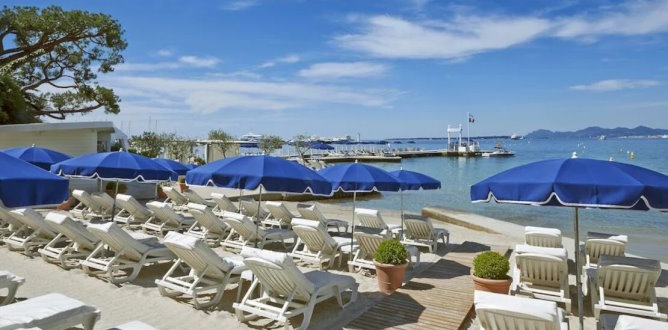Antibes resort. Picasso Museum Antibes
Antibes is one of the most famous resorts in the French Riviera. The Picasso Museum in Antibes is one of the top Picasso museums in the world. Pablo Picasso lived 26 years there after World War II and donated 23 paintings to be housed in the Grimaldi Museum on Antibes seafront. Altogether a great resort for a stay. French Riviera.
Antibes, the French Riviera resort
Antibes is a charming French Riviera resort. Known for its beautiful Mediterranean coastline, it is famous for its well-preserved Old Town, with narrow cobbled streets, quaint squares, and historic buildings. The Marché Provençal is a lively open-air market where you can find fresh local produce, cheeses, olives, and other regional specialties.
The Musée Picasso is housed in Château Grimaldi, a medieval castle. Picasso lived there for a time in the 1940s, and the museum displays a significant collection of his works.
Antibes is home to Port Vauban, one of the largest and most luxurious marinas in the Mediterranean. It is known for its impressive yachts, including some of the world’s most extravagant private vessels. The town has several beautiful beaches, including Plage de la Salis, which offers a quiet, sandy spot with clear waters, and Plage de la Garoupe, known for its crystal-clear water and scenic views.
Antibes facts. Locate Antibes on French Riviera map.
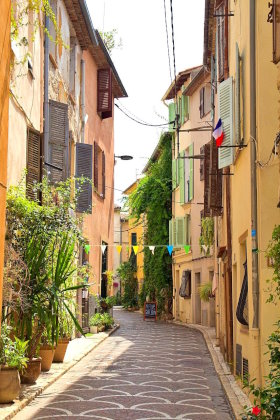
Antibes has a picturesque old town
Picasso in Antibes
Pablo Picasso (1881-1973) arrived in Antibes in the French Riviera in September 1946. Picasso painted three months in Antibes 12th century Castle at the invitation of Romuald Dor de la Souchère, the director of the Grimaldi Museum housed in the castle.
Picasso produced famous works in Antibes including "La joie de vivre". In 1947, Picasso moved to Vallauris near Antibes. Picasso stayed in the French Riviera until his death in Mougins, a village close to Antibes, in 1973.

Antibes is one of the top French Riviera resorts
Picasso Museum Antibes
Pablo Picasso donated 23 paintings and 44 drawings to the Grimaldi Museum. In 1966, The Grimaldi Museum was turned into the Picasso Museum Antibes, one of the best Picasso Museums in the world with Picasso Museum Paris and Centre Pompidou, both in Paris.
The Picasso paintings are the heart of the Picasso Museum. They are complemented with works by Nicolas de Staël and Hans Hartung among other great 20th century artists. The Picasso Museum lovely setting and collections are a must for art lovers.

Picasso Museum dates back to the 12th century
Visit Picasso Museum in Antibes
Antibes 06000 France
Museum hours: Picasso museum is open every day except on Monday and on January 1st, May 1st, November 1st, December 25th. September 16th to June 14th: 10am to 1pm, 2pm to 6pm. June 15th to September 15th: 10am to 6pm. Ticket office closes at 12pm and 5.30pm. Tickets: 8 euros.
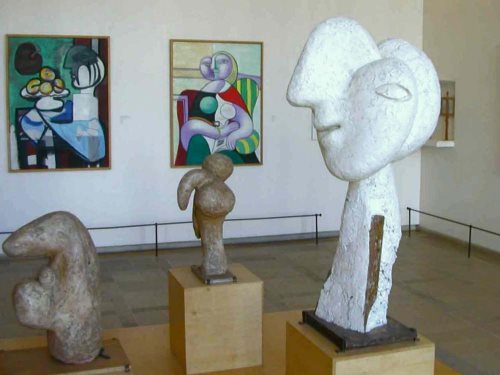
Picasso Museum is housed in Grimaldi castle
Stay in Antibes
Antibes is ideal for a stay in the French Riviera. See the Picasso Museum, the Foundation Hans Hartung, the old Antibes village and Cap d'Antibes.
Close to Léger Museum in Biot, Cannes, Nice and other French Riviera sights, Antibes is a great destination for a week-end or a week. Fly Air France or Easyjet to Nice, then rent a car. Locate Antibes on French Riviera map.
There are many excellent hotels and apartments in Antibes.

Antibes market is picturesque
Stay in top French Riviera hotel or apartment
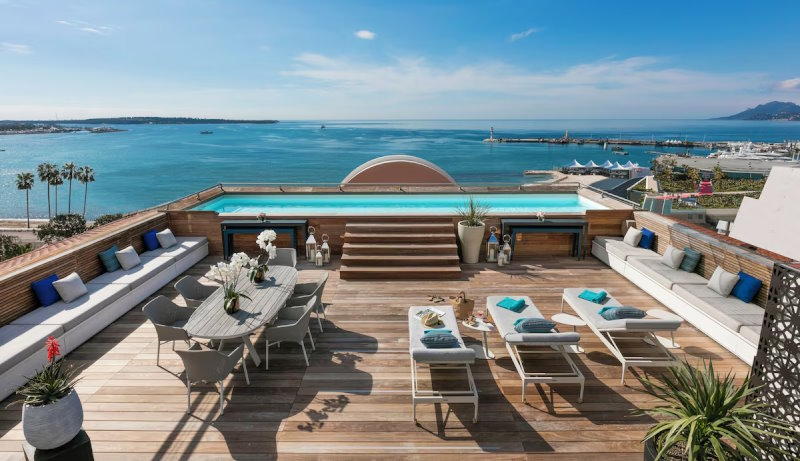
Hôtel Belles Rives in Antibes
For almost a hundred years, Hôtel Belles Rives has mastered the art of hospitality in Antibes resort. This Art Deco hotel welcomed Francis Scott Fitzgerald and his wife Zelda. Guests love nothing more than coming back to this delightful high-end hotel, an intimate and welcoming place where luxury is omnipresent yet discreet, down to the smallest details. The hotel’s rooms and suites have been designed to create a soothing haven of well-being.
One of the hotel’s most unique claims to fame is its historic connection to waterskiing. It’s said that the first-ever water ski race took place in the waters just off the Belles Rives. It hosts the one of the world’s oldest water ski clubs, offering an exhilarating experience on the pristine waters of the French Riviera. Established in the 1930s, the club attracts both amateurs and professionals. Guests enjoy expert instruction and state-of-the-art equipment, making it an ideal spot for both seasoned skiers and beginners.
Antibes - Juan-les-Pins 06160 France
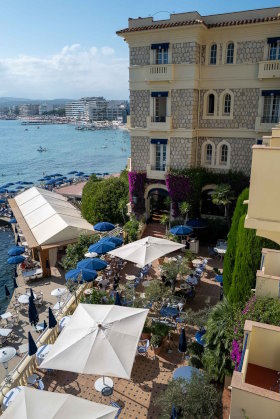
Hotel Belles Rives in Antibes is famous
Antibes and French Riviera tour
In half a day, discover the famous French Riviera towns of Cannes, Antibes and Saint-Paul-de-Vence on a minivan tour from Nice.
The view of the Mediterranean will accompany you on your journey. An afternoon dedicated to discovering Antibes, Cannes and its Croisette and the pretty village of Saint-Paul-de-Vence. Places to visit: Departure for Antibes along the seafront to discover the ramparts and Cap d'Antibes, while admiring the view of the Alps. On to Cannes and its famous Croisette with its palm trees, luxury boutiques and hotels. Stroll through the old town. Finally, off to Saint-Paul-de-Vence and its ramparts, for a stroll through the cobbled streets typical of medieval villages. By comfortable, air-conditioned minivan limited to 8 people. Take advantage of this afternoon to discover the treasures of the coast and play star on the Croisette!

La Croisette is the famous Cannes boulevard
La Joie de Vivre - Pablo Picasso - Picasso Museum Antibes
Created in 1946 in Antibes and exhibited in Picasso Museum Antibes, le Joie de Vivre is a unique pictorial work in panoramic format. With the difficulty of supply at the end of the war, Picasso used what he found: paint for boats and plates. Technically, the work is made with unusual materials, industrial oil painting on fiber cement board. These materials give a fluid paint, visible matter (brushstrokes) showing all the energy of the execution. The general meaning is that of the classic theme of a bacchanal, happiness linked to the found peace. Two musicians, a centaur on the left and a faun on the right, play aulos and diaula (a kind of single or double oboe from ancient Greece). A naked nymph is playing the tambourine and dancing with two kids. On the left, a sailboat is sailing towards the outside of the painting. On the right, a vine asserts the bacchanal. The work presents three emblematic elements specific to Dionysos: the goats that refer to the Dionysian animal; the aulos and the percussion which are used in the dionysies, and the dance of the nymph.

Picasso and the French Riviera
Pablo Picasso lived in the French Riviera from 1946 to 1973. During the last twenty-seven years of his life, the artist produced many works. Between Antibes and Mougins, via Cannes or Vallauris, the Spanish exile had found a second home. A land that sheltered the loves of the man, and the moods of the artist. From 1919, the Côte d'Azur was a sweet holiday resort for Picasso, who stayed in Saint-Raphaël during the summer, in the company of Olga. In 1923, the wild setting of Cap d'Antibes guided his brush dipped in the colors of ancient mythology (La Flûte de Pan). A year later, he took advantage of his summer stay at the Villa Vigie in Juan-les-Pins to sketch his Book of Abstract Drawings and paint Paul as a Harlequin. And while the brown plague threatened Europe, it was still in Cannes that Picasso spent his holidays with Olga and his son Paulo in 1933.
With his daughter Maya, born of his affair with Marie-Thérèse Walter, he found refuge in Juan in 1936, while Dora Maar joined him in Mougins during the month of August, then in July 1938. After Guernica, Picasso definitively turned his back on Franco's Spain to settle on the Cote d'Azur in 1946. Symbol, this fresco War and Peace (1952), painted in the Romanesque chapel of Vallauris. Previously, it was on the maritime ramparts of Antibes that Picasso, 55, had established his fame and his talent. In the studio offered to him by the curator of the Grimaldi museum, now the Picasso museum. In two months, the painter created 70 works there, as if to capitalize before winter. Pablo Picasso moved into the Villa Californie, which overlooks the Croisette in Cannes (1955). In June 1961, he moved to Mougins. He died there of a pulmonary embolism in 1973.
